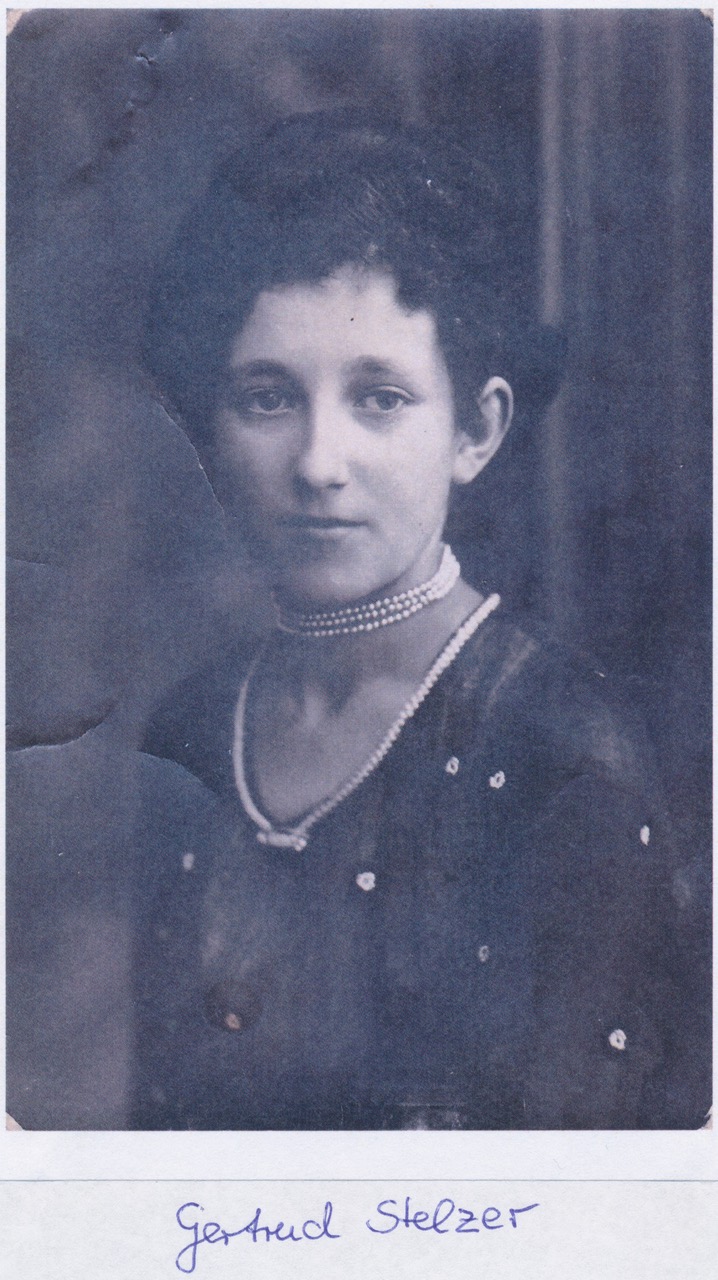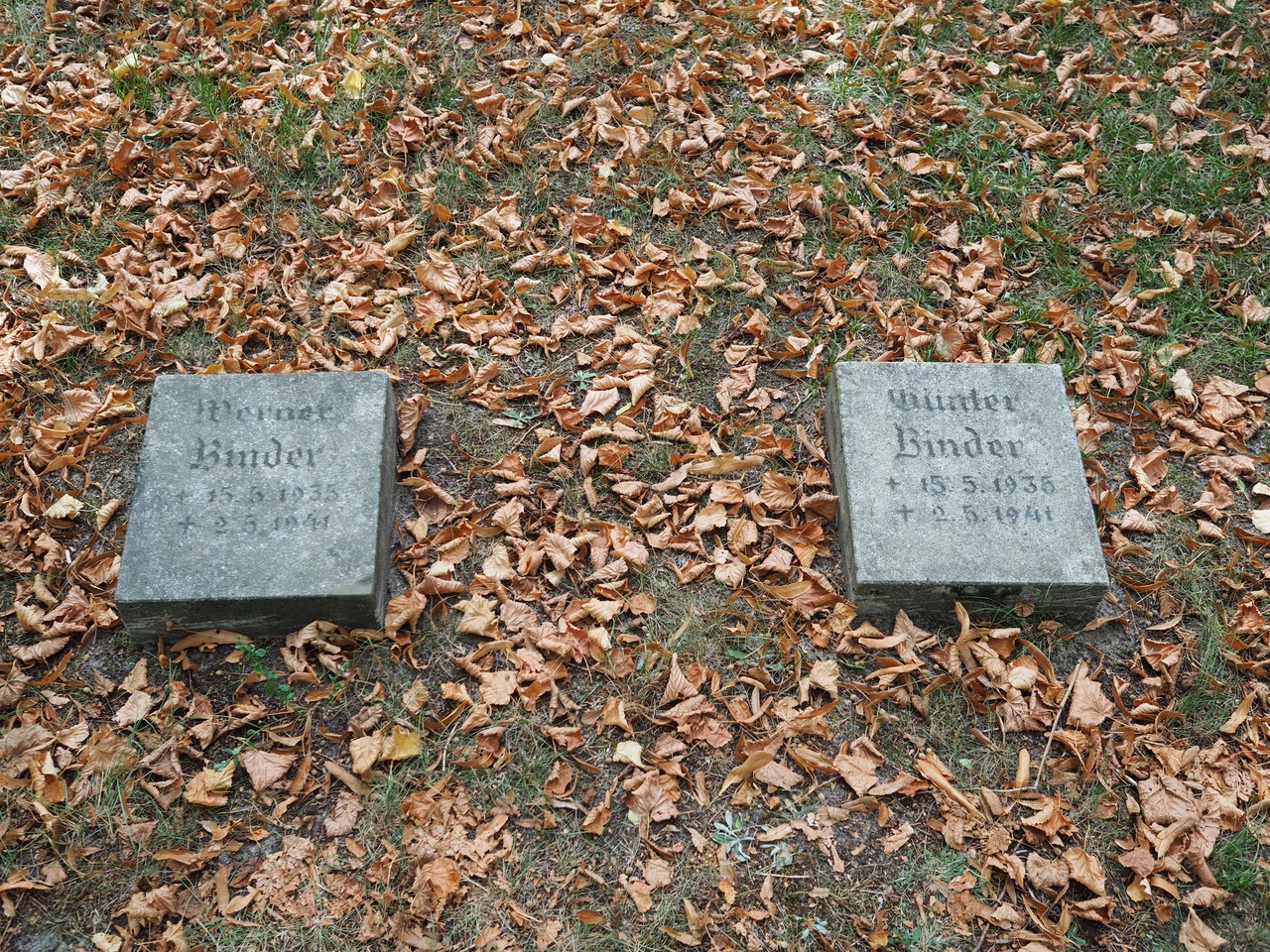Werner and Günter Stelzer (Binder)
born in 1935 in Berlin, Germany
died in 1941 in Brandenburg, Germany

The death of the identical twins Werner and Günter Stelzer (Binder) on the same day, May 2, 1941,
in Brandenburg-Görden Psychiatric Hospital is highly conspicuous. Extensive archival material
exists on both, suggesting that they were considered “special cases” for research purposes.
Not least because of their simultaneous death, there is a strong suspicion of deliberate killing
in order to enable a comparative autopsy.
As early as one year after their deaths, assistant physician Hans Fischer of the Landesanstalt
Görden published an article about the twins in the Zeitschrift für die gesamte Neurologie und
Psychiatrie (Journal of Neurology and Psychiatry). Their death on the same day was mentioned
only in a subordinate clause within the case description: “Due to insufficient care options in
the parental home, the twins were admitted to the Landesanstalt Görden on October 18, 1940,
where they remained until their death on May 2, 1941.”
The twins were regarded as an example suggesting that the presumed hereditary nature of an
illness might not necessarily apply. Pathological-anatomical findings pointed to an external
cause of the hydrocephalus from which both children suffered. The conclusion – confirmed by
the physician and brain researcher Julius Hallervorden (1882–1965) of the
Kaiser-Wilhelm-Gesellschaft – that the illness of the twins
“thus has nothing to do with a hereditary condition”, also appears in Günter Stelzer′s medical
file. Julius Hallervorden responded to the mother, who had come to Görden after the death of her
children to ask about the results of the “brain examination,” stating: “A great deal depends on
this statement, given my circumstances, which I have explained to the doctor.”
The twins were born out of wedlock at a clinic in Berlin-Neukölln. Immediately after their
birth, they were placed in the care of the mother's sister Martha Böers in
Dittersbach / Thuringia, with whom they stayed until her marriage, which only took place in
January 1940. The background and family circumstances were complicated, as researched by
Anneliese Braune, the goddaughter of Gertrud Binder, together with her husband Jürgen Braune.
She writes:
“My godmother Gertrud gave birth to the children out of wedlock in 1935, at the Brandenburg
Landesfrauenklinik [Regional Women′s Clinic] in Berlin-Neukölln. She was there as a woman who
provides menial labour in the hospital in exchange for being able to give birth (Hausschwangere).
A few weeks later, after a complicated uterine involution and weaning the children, the boys
were taken to Gertrud′s sister in Dittersbach/Thuringia for care. They remained there until
Gertrud married Walter Binder in 1940. On January 14, 1940, they were legally recognized as
legitimate children and given the name Binder at the registry office.”
However, on the farm in Müllersthal (Oststernberg), where the twin′s mother lived with her
own mother on a farmer’s estate, the paternity of Walter Binder, later listed as the father,
was highly questionable. According to Anneliese Braune’s research, the farmer who managed the
estate was more likely to be the father, having had a romantic relationship with Gertrud Stelzer
during the 1930s. He had aspired to a career in the German military but started in police
regiment 2, which fought partisans in 1942. He did not want to marry her. He, later residing
in Zielenzig, is believed to have initiated the institutionalization of the children in June 1940.
Walter Binder, who appears in the records as the father, was also a farmer but ten years younger
than the mother and appears in the late 1930s in the records as an officer in the Wehrmacht.
He died in 1944 on the Eastern Front. The mother, Gertrud Binder, worked as a housekeeper until
her marriage. Her parents were originally from Neutomischel (today Wielkopolska Voivodeship
in Poland) and Cicha Góra (a village in Nowy Tomyśl County, also in Greater Poland). Her father
had been an “innkeeper and traveller” and died in 1936. According to the medical history, there
were no reports in the family of “seizures or venereal diseases.”
According to the mother, both children suffered from rickets in their first year of life and had
suppurating glands in their second. In their third year, they had measles followed by whooping
cough. At six months old, Werner Stelzer suffered from intestinal catarrh and was sent to the
children’s home Luhnsmühle in Brenstadt near Sagan. At that point, the twins were separated,
otherwise they were always together. If one of the children became ill, the other would fall
ill shortly thereafter, according to the medical file.
Günter Stelzer was reportedly always slightly more developed. However, both were severely
developmentally delayed. They responded to being called and to their names. Their language
development was considered highly delayed. They learned to speak at about two and a half years
old, but could only pronounce a few, unclear words. They were considered unclean, as they did
not indicate when they needed to relieve themselves.
In the family history, which was identical for both, it was stated: “Günter enjoys playing
with children and often seeks them out. Werner, on the other hand, keeps more to himself. The
children are reserved toward strangers.” Günter Stelzer could play with building blocks, but his
brother could not.
In 1940, the twins lived with their parents in the Brandenburg district of Oststernberg.
On June 7, 1940, the district physician in Zielenzig referred them to a residential facility
for long-term care due to their severe intellectual disability. Why they were not admitted to
the Görden institution until October 24, 1940, is not stated in the file. However, a report from
the Landesfrauenklinik (Regional Women's Clinic) in Berlin-Neukölln includes a note that the
mother had been advised after birth to “go to an infant home with her children but went home
against medical advice.” This possible indication of maternal resistance might, alongside the
general difficulty of obtaining a place, explain the three-month delay in admission. Goddaughter
Anneliese Braune writes:
“From the outside, the children’s condition was not immediately apparent. In the family, it was
said after the war that in 1940 the children were sent to a sister [...] in Velten, ‘because
things on the farm could no longer be managed with them’.”
Upon arrival in Görden, following standard procedure, the twins were admitted to ward “CF3” by
institution physician Friederike Pusch (1905–1980), with a neurological, psychiatric, and
motor-sensory assessment as well as bacteriological diagnostics. Both twins underwent
encephalography, a painful procedure where spinal fluid is withdrawn, and air is injected
into the brain to create a spatial X-ray image. A genealogy (Sippentafel) was created, and
photographs of the six-year-old brothers were taken. As shown in images in the above-mentioned
publication, more photographs were taken and printed than are currently found in the individual
files.
The assigned diagnosis was confirmed, though the cause remained unclear. Due to the simultaneous
manifestation in both twins, a hereditary cause was long considered likely. The department in
Görden noted that the children did not perceive the change in environment. Both appeared
relatively indifferent to their surroundings. Werner Stelzer was generally assessed as
“even more severely impaired than his twin brother:” “He does not imitate, although he never
leaves his brother. While Günter is able to use a spoon and eat independently, Werner must be
fed. He does not attempt to take the spoon, even when handed to him. (…) When he sees his
brother walking around, he also stands up and follows him aimlessly.” Both exhibited “the same
slowness, clumsiness, and awkwardness.”
The twins were apparently deliberately starved and lost weight. On April 24, Werner Stelzer’s
file reads: “In his intellectual and motor development, W. has shown no change since the last
report. He has made no progress. Today he has contracted scarlet fever with high fever.” An
identical note is found in Günter Stelzer’s file. On May 2, 1941, Werner Stelzer’s file states:
“After the rash subsided, symptoms of bronchopneumonia developed, which today led to
exitus letalis [death].” A nearly identical entry appears in Günter Stelzer’s file on the same
date.
The twins’ bodies and brains were extensively examined, photographed, etc. In both their files
are not only pictures of the children’s occiputs but also a sealed envelope labelled
“scalp hair.” Even more images are found in the aforementioned scientific article.
Werner Stelzer’s autopsy report compares the findings to those in his twin brother
Günter Stelzer. Both were in a “reduced nutritional state.” According to the article, the brain
autopsies were conducted by Julius Hallervorden himself. The autopsy protocols are not found in
the medical files.
The identical death from bronchopneumonia following scarlet fever, with a suspiciously rapid p
rogression from relative health, makes deliberate killing likely. There is strong evidence to
support the assumption that their deaths occurred in the context of their perceived scientific
“utility.”

Their bodies were buried on May 8, 1941, in “institution coffins” at the Landesanstalt Görden.
Their specimens were listed in various inventories and were already being used for research purposes
at the time. They appear on the list of specimens designated in 1990 for burial at the Munich
Waldfriedhof (Forest Cemetery).
Apparently, the mother of the twins had a personal meeting “with the doctor and female doctor” on
the occasion of her children′s deaths. On June 16, 1941, she inquired “what result had been obtained
from the brain examination.” She was evidently not kept in the dark about the brain autopsy and had
been promised a statement, as she wrote that it was very important to her. On July 26, 1941, Julius
Hallervorden wrote to her that “the illness of both is due to a previous brain inflammation, thus
has nothing to do with a hereditary condition.” If the condition had been presumed hereditary, she
herself and any future children would have come under scrutiny by the “hereditary health bureaucracy.”
Anneliese Braune reflects on the forgetting that long overshadowed the children’s fate:
“Gertrud was my godmother, and I liked her very much. I learned of her children as a girl through a
picture of the two four-year-olds on tricycles. It didn’t seem like a disability to me, even when
I looked at it again as an adult. Who could have taken the photo and where? Why did the children
look so normal back then? Were they simply severely neglected once it became clear something was
wrong?”
The mentioned photo no longer survives. The burial site, too, remained unknown for a long time.
“Until 1957, the cemetery in Görden was relatively well-kept; one could have taken the train from
Biesenthal and laid down a few flowers. But no, they probably just wanted to forget, to avoid
admitting the children had been unwanted from the beginning. [...] That we were deliberately led a
stray by family members hurts especially. If even one person in the family had had the courage
to at least name the burial site, many things would have become clear, painful as it may have been.
But in 2004, the neglected cemetery in Brandenburg Görden was restored. During the restoration, the
two small gravestones were uncovered beneath the grass.”
This biography was written by Uwe Kaminsky.
© 2025 by Uwe Kaminsky, licensed under
CC BY 4.0


